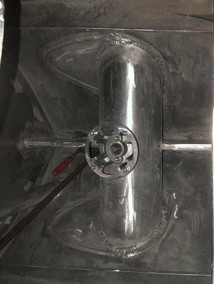Explorer Yacht Bow Thruster
- Chris Leigh-Jones
- Feb 7, 2023
- 3 min read
Updated: Apr 20, 2023
The last yacht bow thruster I used ran on 3000VDC, connected to the shaft generator on a general cargo ship running with a Controllable Pitch propeller. Sometimes experience may be exciting but offers little help for a particular situation. We needed a somewhat more miniature thruster for Vanguard, so how did this come about?
Firstly we spoke with the company supplying our Dynamic Positioning system, Praxis.
We have a very long and narrow hull, and consequently, slewing torque from the propellers off-center line was relatively low. Add to this the length of the hull providing windage for leverage; the request was for a unit above 12kW. We will be connecting the bow thruster with our dynamic positioning system, so we need a long-run capability and proportional speed/thrust control for additional power. So far, so good.
The next thing we did was examine the hull. Especially within the forepeak, fore, and aft watertight bulkheads. This defined the physical limitations of the distance across the drive shaft and shaft diameter. Further forward provides a more effective turning force but at the expense of space. A large-diameter tunnel will run more quietly, but there is a minimum immersion depth for the top of the tunnel to limit air entrainment and the keel plate to limit flow bypass. This provides the dimensional limitations to add to the characteristics in the previous paragraph.
Read also: Aluminum, Fiberglass, Steal or Wooden Hulls?
Read also: XPM-78 Designing the First Hull
Lastly, we looked at operating parameters: voltage, current, and control. Our preference was for a design operating on the 400VDC three-phase AC voltage. We have it available in the engine room. Three phase balances each line load, single phase would drop all 15kW on to a single phase and unbalance the whole system. It removes the necessity of additional batteries in the forepeak to counteract line voltage drops on startup when using. DC powered system.
Find the best Yacht Bow Thruster
Then it's off to the marketplace to see what's available, which seems to be less choice than we expected. We had fallen into the realm of units designed for commercial applications and, within that, at the lowest end of designs within that scope. Our eventual selection was a 15kW unit from Sidepower. 250mm O/D tunnel, twin, skewed counter-rotating propellers. The bronze and steel drive line gearbox comes with complete galvanic isolation. We also have a long-run proportional control system using their proprietary S-Link CAN bus. S-Link is converted to Ethernet RS485 using a signal gateway.
Yacht Bow Thruster Installation
The first item fitted to our hull was the cross tunnel, fully welded to the keel plate and forefoot plates. Hull plates were then streamlined aft of the tunnel by creating a scollop-shaped cutout. Sidepower installation manual states that the rear wall of the tunnel should not be visible from the bow, (see enclosed photo below). This improves flow across the tunnel face when underway or in waves. The tunnel was fully welded to the 15mm forefoot hull plating and any internal stringers or frames. A generous fillet weld allowed for the corners to gain a good radius. Three-phase 400VDC drive motor was mounted vertically in the forepeak to save space. We mounted the speed control inverter in the engine room as this minimized power line currents and made control connections much shorter.
The thruster will be controlled via a fully redundant ethernet backbone as part of the Praxis DP and Steering system. It's not a critical component, Vanguard will be maneuverable without it but neither should it be designed to fail.
Chris Leigh-Jones
I remember reading a comment on setsail.com where Steve Dashew mentions the bow thruster on an FPB-78 is essentially redundant as the vessel was in itself very maneuverable. Our hull is slightly narrower by proportion so it will be interesting in the sea trials too see if the same hold true for Vanguard. I'll let you all know in June!





















Andy - Yes, the Sidepower VFD is supplied with three phase power from the yachts 3 phase bus bars. 400VAC approx. The VFD drive will change the output frequency but the power remains three phase in and out. Sidepower recommend that the connecting cables between VFD and Thruster motor are shielded. On that basis I'd suspect it's a noisy signal with minimal line filtering but it remains 3 phase throughout. We did look at DC thrusters also. The major problem was voltage drop between our power batteries and the thruster in the forepeak space. A typical way of minimizing this is to have additional battery storage close to the motor. No one was keen to add weight in this loc…
You run the speed control inverter / VFD (variable frequency drive) from 3 phase AC right?
First thing the inverter does is to rectify this to DC, if I understand correctly. Could the VFD not be directly connected to the high voltage drive battery DC, bypassing the 3 phase AC, or is there a mismatch of the voltages etc?
Andy